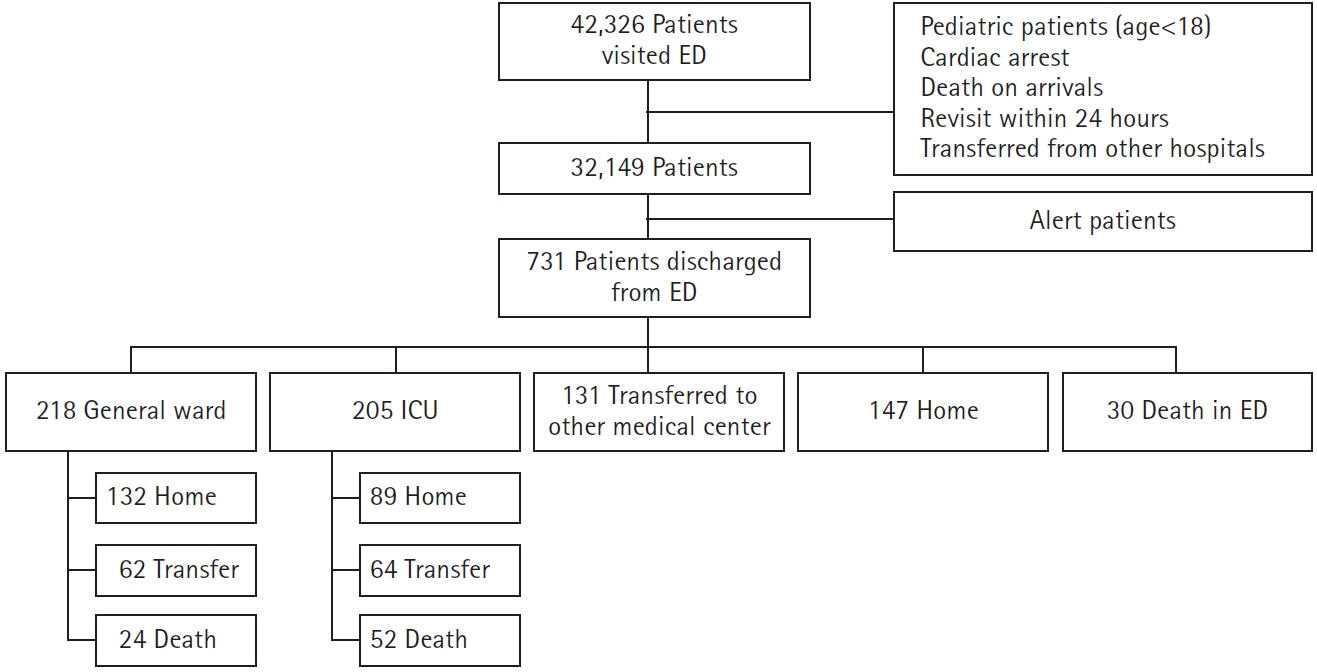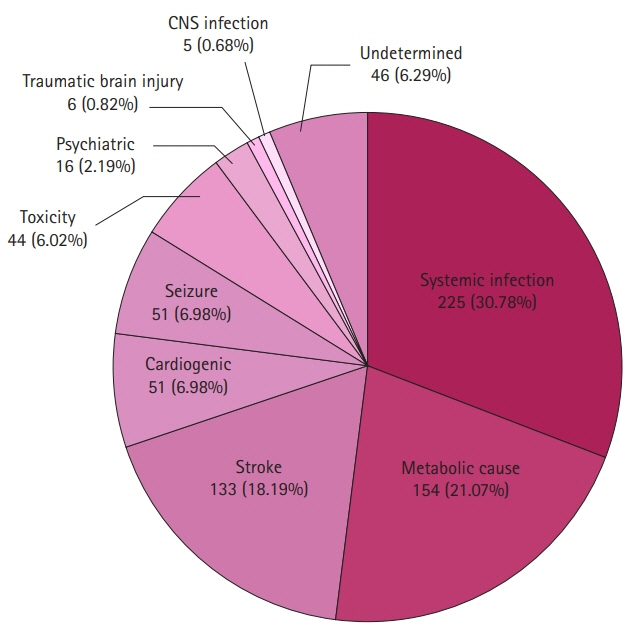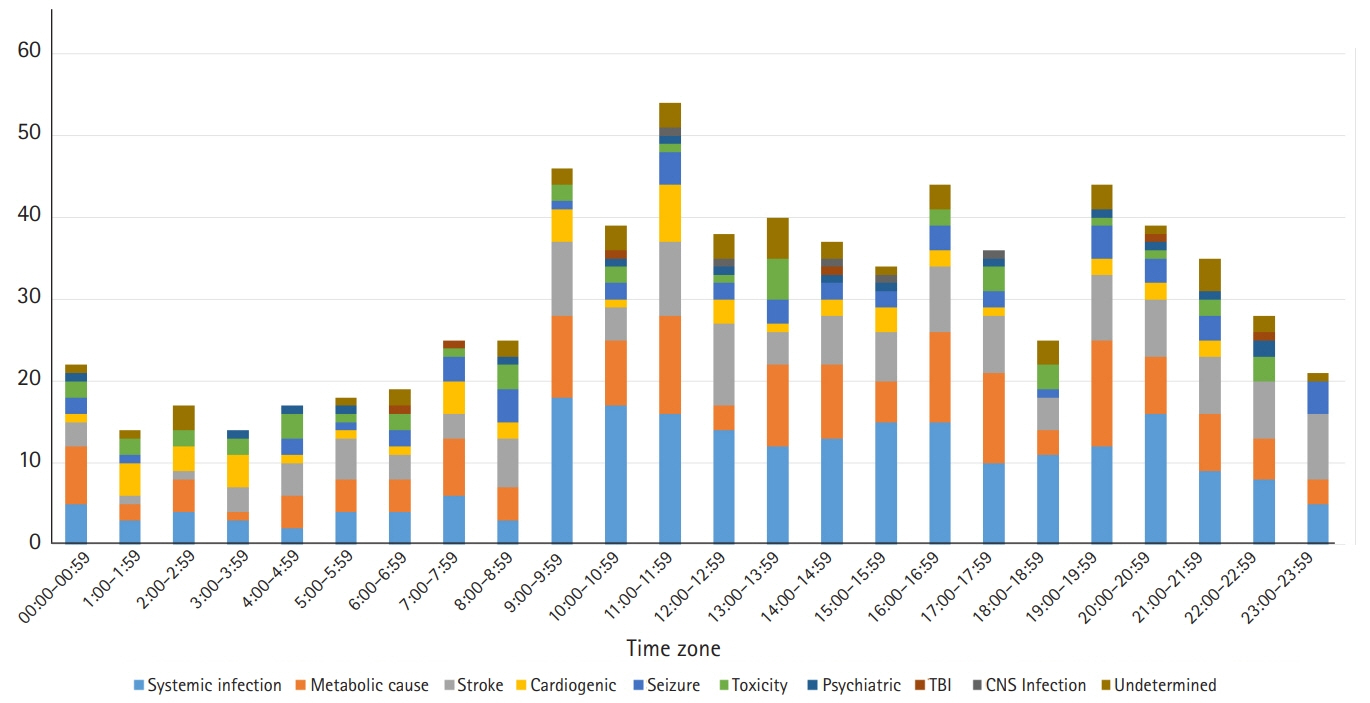J Neurocrit Care.
2020 Dec;13(2):86-92. 10.18700/jnc.200010.
The etiologies of altered level of consciousness in the emergency department
- Affiliations
-
- 1Department of Emergency Medicine, Keimyung University School of Medicine, Daegu, Republic of Korea
- 2Department of Internal Medicine, Keimyung University School of Medicine, Daegu, Republic of Korea
- 3Department of Neurology, Keimyung University School of Medicine, Daegu, Republic of Korea
- KMID: 2509937
- DOI: http://doi.org/10.18700/jnc.200010
Abstract
- Background
New-onset altered level of consciousness (ALC) is a common condition in patients visiting the emergency department (ED). We evaluated the clinical characteristics, causes, and prognosis of adult patients presenting with ALC at an ED of a university hospital to determine the etiologies, outcomes, and destinations of these patients.
Methods
The medical records of patients with ALC who visited the ED of a university hospital from February 2019 to January 2020 were reviewed. The cause of ALC and its classification were carefully decided by agreement through a discussion among board-certified clinicians in emergency medicine, neurology, and internal medicine.
Results
Of the 731 patients with ALC in the ED, whose mean age was 68.81±16.40 years, most were in their 80s (198, 27.09%). The most common etiology of ALC was systemic infection (30.78%), followed by metabolic causes (21.07%) and stroke (18.19%). Extracerebral and intracerebral etiologies of ALC in the ED accounted for 51.85% and 26.68% of the cases, respectively. The overall mortality of ALC in the ED was 17.67%. The largest number of ALC cases of 443 patients, i.e., 60.6% of all ALC patients in the ED were reported within the time zones of 11:00–12:00 and 07:00–19:00.
Conclusion
This study identified the extra-cerebral etiologies as the major causes of ALC in the ED.
Figure
Reference
-
1. Kanich W, Brady WJ, Huff JS, Perron AD, Holstege C, Lindbeck G, et al. Altered mental status: evaluation and etiology in the ED. Am J Emerg Med. 2002; 20:613–7.
Article2. Naughton BJ, Moran MB, Kadah H, Heman-Ackah Y, Longano J. Delirium and other cognitive impairment in older adults in an emergency department. Ann Emerg Med. 1995; 25:751–5.
Article3. Smith AT, Han JH. Altered mental status in the emergency department. Semin Neurol. 2019; 39:5–19.
Article4. Völk S, Koedel U, Pfister HW, Schwankhart R, Op den Winkel M, Mühlbauer K, Klein M. Impaired consciousness in the emergency department. Eur Neurol. 2018; 80:179–86.
Article5. Schmidt WU, Ploner CJ, Lutz M, Möckel M, Lindner T, Braun M. Causes of brain dysfunction in acute coma: a cohort study of 1027 patients in the emergency department. Scand J Trauma Resusc Emerg Med. 2019; 27:101.
Article6. Kekec Z, Senol V, Koc F, Seydaoglu G. Analysis of altered mental status in Turkey. Int J Neurosci. 2008; 118:609–17.
Article7. Jeon JC. The etiology and outcome of seizures in the emergency department. Epilia Epilepsy Community. 2019; 1:18–22.
Article8. Koita J, Riggio S, Jagoda A. The mental status examination in emergency practice. Emerg Med Clin North Am. 2010; 28:439–51.
Article
- Full Text Links
- Actions
-
Cited
- CITED
-
- Close
- Share
- Similar articles
-
- The Etiologies of Altered Level of Consciousness in the Emergency Department: Before versus after Coronavirus Disease-19
- The etiology and mortality of altered level of consciousness in the emergency room: before and after coronavirus disease
- Clinical Analysis on Patients Presenting with Altered Consciousness in the Emergency Room of S. N. U. H
- The Clinical Analysis on the Altered Mental Status in the ED
- Missed Traumatic Rupture of the Diaphragm




